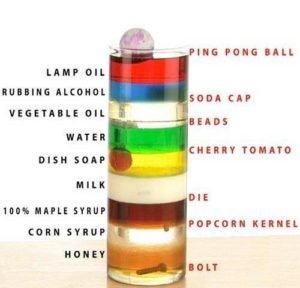
Layering liquids
Light corn syrup
Water
Vegetable oil
Dawn dish soap (blue)
Rubbing alcohol
Lamp oil
Honey
Graduated cylinder
Food Coloring or Coloring Tablets
Food baster
9 oz portion cups
It is not necessary to layer all of these liquids but use the ones you have. Measure 8 ounces of each type of liquid into the 9 ounce portion cups. Color each of the liquids. Light corn syrup is easier to color than dark syrup. The only liquids that you may not be able to color are the vegetable oil and the honey.
Start the column by pouring the honey into the cylinder. Then pour each liquid SLOWLY into the container, one at a time. It is very important to pour the liquids slowly and into the center of the cylinder. Make sure that the liquids do not touch the sides of the cylinder while you are pouring. It’s okay if the liquids mix a little as you are pouring. The layers will always even themselves out because of the varying densities. After the column of liquids is formed let it sit in a safe place to observe. Pour the liquids in the following order:
Honey
Corn syrup
Dish soap
Water
Vegetable oil
Rubbing alcohol
Lamp oil
The same amount of two different liquids will have different weights because they have different masses. The liquids that weigh more (have a higher density) will sink below the liquids that weigh less (have a lower density).
Material Density
Rubbing Alcohol .79
Lamp Oil .80
Baby Oil .83
Vegetable Oil .92
Ice Cube .92
Water 1.00
Milk 1.03
Dawn Dish Soap 1.06
Light Corn Syrup 1.33
Maple Syrup 1.37
Honey 1.42
To test this you can measure the weights of equal portions of each liquid. You should find that the weights of the liquids correspond to each different layer of liquid. By weighing these liquids, you will find that density and weight are closely related.
Density is how much “stuff” is smashed into a particular area… or a comparison between an object’s mass and volume. Remember the all-important equation: Density = Mass divided by Volume. Based on this equation, if the weight (or mass) of something increases but the volume stays the same, the density has to go up. Likewise, if the mass decreases but the volume stays the same, the density has to go down. Lighter liquids (like water or rubbing alcohol) are less dense than heavy liquids (like honey or corn syrup) and so float on top of the more dense layers.

